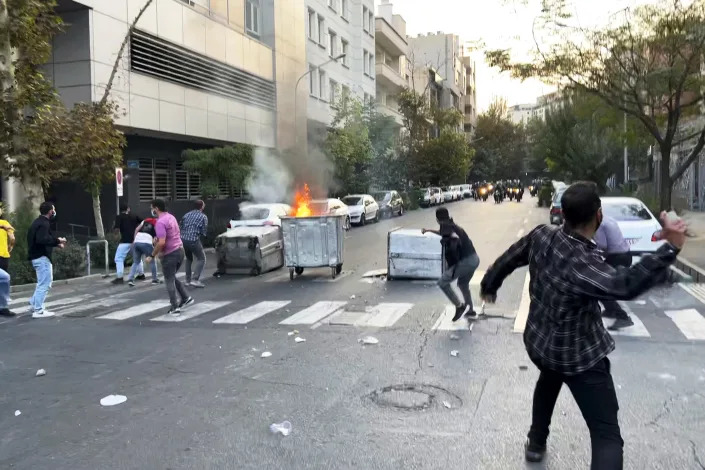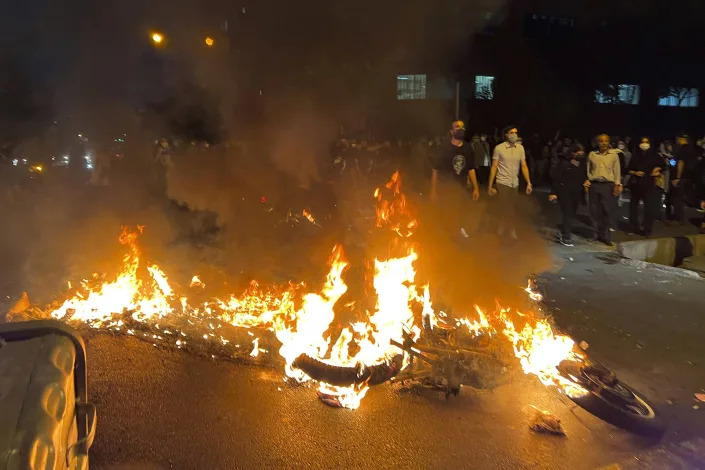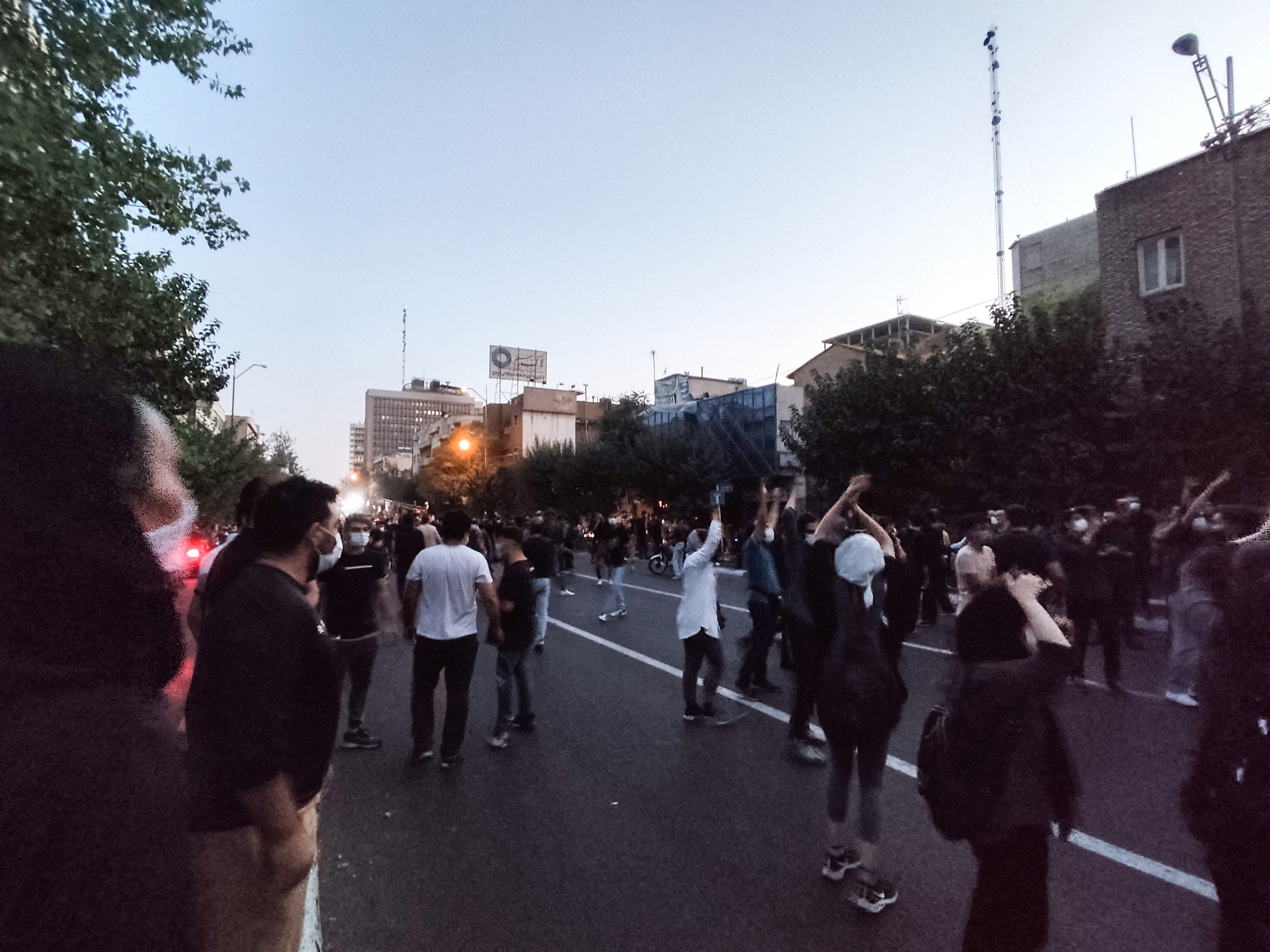Muslim women are taking off their headscarves and cutting their hair on TikTok to protest Iran's hijab rules following the death of 22-year-old Mahsa Amini
Charissa Cheong
Wed, September 21, 2022

22-year-old Mahsa Amini died on Friday after being arrested by Iran's Islamic morality police.
Police detained Amini on suspicion of breaking hijab-wearing rules, reports say.
Muslim women are now cutting their hair and hijabs on TikTok in protest.
Women in Iran are taking off their headscarves and cutting their hair to protest the death of 22-year-old Mahsa Amini.
Amini died in a Tehran hospital on Friday after being arrested by Iran's Islamic morality police on Tuesday on suspicion of not correctly wearing a hijab — a head covering traditionally worn by Muslim women and is mandatory in Iran — according to reports.
Tehran police said Amini was arrested for the purpose of "justification and education" about the hijab, and told her family she died of a "sudden" heart attack. Her family say she had no known heart conditions, and witnesses said they saw police beating her up inside a van, according to BBC News.
On September 18, the day of Amini's funeral, protests erupted in Iran, with women removing their headscarves and waving them in the air to protest the hijab-wearing rules that led to the arrest of the 22-year-old.
Now, Muslim and Iranian women based all over the world are joining the protests by taking off their headscarves and cutting their hair in protest on TikTok and Instagram.
@persianziba Today exactly two years ago I started wearing hijab, today I cut my hair for #mahsaamini , who was an Iranian woman that got unal!ved in Iran because of the mandatory hijab law. I cannot show the video of me cutting my hair out of religious reasons (On my story there is a censored version of the video) so as a symbol of solidarity I made a video cutting my scarf as well in order to spread the message. I am wearing one of our traditional Persian scarfs around me to represent my people as an Iranian woman. I cannot go into detail for my own safety, so please do the research and spread our message. #fy #fyp #foryou #foryoupage #freedom #help #helpus #iran ♬ original sound - em🤍
In one video with 930,000 views, a woman can be seen cutting up her black headscarf with a pair of scissors. The caption under the video read, "Today exactly two years ago I started wearing hijab, today I cut my hair for #mahsaamini." The user wrote that she did not want to cut her hair on camera for "religious reasons," but filmed herself cutting the headscarf "to spread the message."
"My heart goes out to all my female friends fighting for their basic human rights in Iran," wrote one TikToker under a video with 430,000 views, where she could be seen snipping her long hair into a shoulder-length bob.
@mayamahyari For #Mahsa Amini. My heart goes out to all my female friends fighting for their basic human rights in Iran. #mahsa_amini #mahsaamini #no_to_islamic_republic_of_iran #humanrights #womenpower #griving #Iran #iranianwomenlivesmatter #iranianwomen ♬ original sound - em🤍
Some women who don't identify as Muslim have also been posting tributes to Amini on TikTok, saying they want to "stand with Iranian women." One TikToker took part in the hair-cutting trend and showed herself standing in front of a mirror with a newly-shaved head after a caption appeared on the clip saying, "Candian women stand with you."
@altruisticmama Say her name, bring her justice, Mahsa Amini #iraniantiktok #mahsaamini #bringherjustice #oneworld #onepeople #iranianprotests2022 #wehearyou #justice #womenempowerment #women4womenrights #isupportiranianwomensequality ♬ original sound - em🤍
Many of these TikTok videos used audio from "Another Love," a pop song by English singer Tom Odell. The song is also being used on TikTok to share clips filmed at protests in Iran following Amini's death, according to captions under the videos.
Amnesty International and Human Rights Watch have both called for criminal investigations into Amini's death. Iranian state-run news agency IRNA reported that President Ebrahim Raisi has asked Iran's interior ministry to "investigate the cause of the incident with urgency and special attention.
Iran restricts access to WhatsApp and Instagram in response to Mahsa Amini protests
Mohamed Azakir / reuters
Iran has blocked access to Instagram and WhatsApp as its government attempts to subdue protests that began last week following the death of a woman at the hands of local authorities. As of Wednesday, demonstrations across the country had been ongoing for four consecutive days. The protests began over the weekend after 22-year-old Mahsa Amini died in the custody of Iran’s morality police on September 16th. She was arrested for allegedly violating the country’s strict dress code for women.
According to internet watchdog NetBlocks (via Reuters), the Iranian government has gradually restricted web access across much of the country in recent days. The blackout began in Tehran and other parts of Iran when protests first broke out on Friday. On the evening of September 19th, the government extended restrictions to parts of the western Kurdistan province. As of Wednesday, accessing WhatsApp and Instagram through any of the country’s major internet providers was impossible. According to NetBlocks, the current restrictions are the most severe since 2019, when Iran shut down all internet access in response to fuel protests.
Meta did not immediately respond to Engadget’s request for comment. NetBlocks suggests the disruptions are likely to significantly limit the ability of the Iranian people to communicate freely. In theory, Iran’s government may believe that restricting internet access will reduce the likelihood of protestors organizing and allow it to better control the narrative of Amini's death.
US condemns death of Iranian woman in religious police custody while demonstrations erupt in TehranJohn Bowden
Wed, September 21, 2022
The US State Department has condemned the killing of an Iranian woman in police custody after she was detained for not wearing a head covering.
Outrage over the death of Mahsa Amini is growing both domestically inside Iran, according to reports from opposition groups, as well as around the world.
The 22-year-old’s death last Friday has sparked a new wave of resistance against Iran’s religious police and morality rules, including from some prominent left-leaning members of the country’s parliament. Protests have broken out in dozens of cities across the country, according to anti-government sources.
“Mahsa Amini’s death after injuries sustained while in police custody for wearing an ‘improper’ hijab is an appalling and egregious affront to human rights,” a spokesperson for Joe Biden’s National Security Council told reporters. “Our thoughts are with Mahsa’s family and loved ones.”
“Women in Iran should have the right to wear what they want, free from violence or harassment. Iran must end its use of violence against women for exercising their fundamental freedoms,” they continued. “There must be accountability for Mahsa’s death.”
In the US, protests continued with new fervour outside the United Nations’s headquarters as well as a nearby hotel where Ebrahim Raisi, Iran’s president, is staying as he attends a meeting of the General Assembly. Thousands of protesters gathered in the streets on Wednesday, demanding justice.

Anti-Raisi protesters in the streets of New York City (OIAC)
“No one can nor should remain silent regarding the barbaric murders of the young 22-year-old Mahsa Amini by this brutal regime,” said Dr Ramesh Sepehrrad, advisory chair of the Organization of Iranian-American Communities.
Maryam Rajavi, president-elect of the National Council of Resistance of Iran, added that Ms Amini’s death “ignited the powder keg in our rebellious cities”.
“Indeed, the moment this murderer enters the building that is supposed to serve the nations of the world is a moment of shame and disgrace for those who appease the ruling religious fascism, a moment that scars the conscience of humanity,” Ms Rajavi added of Mr Raisi’s upcoming speech to the General Assembly.
At least some in the body appear to agree, as the UN’s High Commissioner for Human Rights has called for an investigation into Ms Amini’s death and alleged torture.
The Biden administration remains engaged in negotiations with Iran’s leadership regarding a possible resumption of the 2015 nuclear deal signed between the Obama administration, Tehran, and a handful of European countries.
Senators on the Foreign Relations committee told The Independent on Tuesday that they had no updates about the status of those negotiations, which are opposed entirely by more hawkish members of Congress.
Wave of protests in Iran reflects seething anger over how its regime treats women
Dan De Luce and Yasmine Salam and Hyder Abbasi and Bianca Britton
Wed, September 21, 2022
She traveled to Tehran to visit relatives, a dark-haired 22-year-old woman from Iran’s Kurdistan region. But outside a subway station, the “morality police” arrested Mahsa Amini for allegedly failing to fully cover her hair, and pulled her into a police van.
Three days later, she was dead.
Amini’s death in the capital has ignited a wave of protests across the country, exposing a raw anger among Iranian women about their treatment by the regime and an unprecedented willingness to defy the government.
"Many people are pointing out that this could be my daughter, my sister, my wife," said Hadi Ghaemi, the executive director of the New York-based Center for Human Rights in Iran. "This has shaken people, that every time a woman leaves home, she might not come back.”
As Iran’s hard-line President Ebrahim Raisi met world leaders in New York for the United Nations General Assembly this week, extraordinary scenes have unfolded in his country, with women removing their headscarves and even burning them in front of cheering crowds, according to videos posted online.
The combination of viral videos and pent-up anger represent a potential “George Floyd” moment for Iran, Ghaemi said, with the regime now “forced into a corner given how innocent this woman was and there was no grounds for having treated her so violently.”
Iran’s U.N. mission did not respond to a request for comment.
Raisi has ordered an investigation into Amini’s death and expressed condolences to her father in a phone call, according to Iranian state media.
“I learned about this incident during my trip to Uzbekistan, and I immediately ordered my colleagues to investigate the matter specially," Raisi said on the call, according to his official website. "I assure you that I will demand this issue from the responsible institutions so that its dimensions are clarified."
The president emphasized that he considers all Iranian girls as his own children. "Your daughter is like my own daughter, and I feel that this incident happened to one of my loved ones. Please accept my condolences," he added.
Eyewitnesses — who were also in the van — told Amini’s father that she was beaten up in the police vehicle on the way to the detention center, human rights groups say. Iranian authorities, however, said she died from a heart attack and called the incident “unfortunate.”
“They said Mahsa had heart disease and epilepsy but as the father who raised her for 22 years, I say loudly that Mahsa did not have any illness. She was in perfect health,” Amini’s father told an Iranian news outlet.
Women’s rights advocates have battled the theocracy from its earliest days after the 1979 Islamic Revolution, protesting the mandatory veil or hijab, along with an array of laws that critics and U.N. rights monitors say render women second-class citizens.
But human rights groups say the women’s movement has gained new strength from social media in recent years and a younger generation more willing to confront the regime.
Since 2017, Iranian women increasingly have taken their opposition to the hijab law online, posting videos of themselves removing the headscarf accompanied by declarations that the government has no right to tell a woman how to dress.
Since Raisi was elected in June, the government has deployed more morality police units, who patrol the streets to ensure women adhere to the regime’s strict female dress code, said Raha Bahreini, Amnesty International’s Iran researcher based in London.
"One very distressing trend in recent months has been the persecution of females who defy compulsory veiling laws. The level of violence that women are facing in the street is really horrific," she said.
"And because there is now more vocal opposition, and campaigning against compulsory veiling laws in Iran, the Iranian authorities are also escalating their attacks on women in the streets," Bahreini said.
But phone cameras and hashtags have become a weapon for activists to push back, mobilize civil disobedience and expose what they allege is a surge in police repression against women.
The digital campaign has been cheered along by Masih Alinejad, an Iranian women rights activist who immigrated to the United States and has become a thorn in the side of the regime.
She invites Iranian women to post their protest videos on social media under her #WhiteWednesdays hashtag campaign. As a result, she has amassed millions of followers online and the FBI alleges she was the target of a recent kidnapping plot by the regime.
For the Iranian government, "the compulsory hijab is not just a small piece of cloth. It is like the main pillar of the Islamic Republic," Alinejad told NBC News.
"When mullahs took power in Iran, what was the first thing they did? They forced women to wear the hijab. Why? Because they use our bodies, like a political platform. So they write their own ideology on our bodies."
The regime likely fears that giving ground on the mandatory hijab rule could open the door to the whole theocratic system unraveling, said Mahsa Alimardani, a researcher at Article 19, a nongovernmental organization that promotes freedom of expression.
"They do not want to concede on this one point in fear that they would have to concede on a lot of other restrictions that help keep the regime in place," she said.
On July 12, when the Iranian government organized an annual “chastity” day to promote the mandatory hijab law, opponents organized counterprotests, posting videos of themselves removing their headscarves in public. Some of the protesters were identified and arrested, but a subsequent online protest on social media under the #No2Hijab hashtag attracted hundreds of thousands of supporters.
"The consequence of this campaign in Iran was to enrage government authorities, clergy and imams,” said Atena Daemi, an Iranian human rights activist who was imprisoned for seven years for protesting the death penalty and undertook three hunger strikes.
Government officials and clerics called for harsher penalties against women protesting the law, she said.
"Women, on the other hand, grew more motivated to continue their fight against the mandatory hijab because with each new action, they discover they are so many, they find each other, and unify and organize for the next movement,” Daemi added.
Human rights experts and activists say Iran has never wavered from its hard-line restrictions on women since the revolution, even when more pragmatic reformists have been in power.
According to Iran’s interpretation of Sharia law, women cannot travel abroad without the permission of a father or husband, are banned from singing or riding bicycles, are denied custody of their children if they remarry, can seek a divorce only under limited circumstances, can be legally married at age 13 and even younger if a court approves and can only inherit an eighth of their husband’s estate. Iran ranked 143 out of 146 countries surveyed in a recent World Economic Forum report on gender pay gaps around the world.
When faced with major street protests in the past, the Iranian government has responded with overwhelming force, including opening fire on unarmed protesters, according to human rights groups and Western governments. At least four people have been killed so far by police in this week’s protests, according to Iranian-focused human rights organizations.
NBC News has not verified the claims.
State media alleged that foreign agents and seditionist elements were behind the street protests.
It’s unclear if the protests will snowball further, or if the authorities will find a way to stifle the momentum of public anger.
Whatever the outcome of the current protests, Amini’s death has meant the regime is “definitely losing the battle for legitimacy,” Alimardani said.
Every prison sentence and arrest meted out by the regime has only radicalized Iranian women and served as a catalyst for more protests, Alinejad and other activists said.
“We have so many Rosa Parks in Iran. To me, I don’t see Iranian women like victims. They are like warriors,” Alinejad said, referring to the U.S. civil rights pioneer.
Daemi, one of the most prominent women’s rights advocates in Iran, said she has no plans to abandon her struggle despite the threat it poses to her health and her family.
“I am confident that humanity will win,” she said. “One day, the sun will break through the gloom.”
This article was originally published on NBCNews.com





